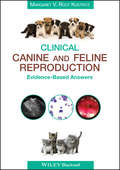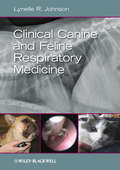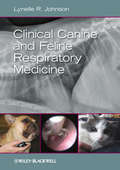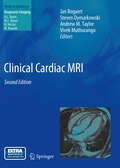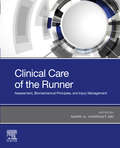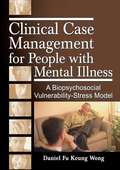- Table View
- List View
Clinical Canine and Feline Reproduction: Evidence-Based Answers
by Margaret V. Root KustritzClinical Canine and Feline Reproduction: Evidence-Based Answers provides quick, reliable answers to the most common questions in canine and feline reproductive and pediatric practice. Written using an innovative question-and-answer format, each answer is designed for quick reference, with the best references listed for further information as needed. Based on the author’s years of experience answering questions on reproduction and pediatrics, Clinical Canine and Feline Reproduction allows the practicing veterinarian to rapidly find and apply evidence-based answers from the scientific literature to their clinical questions.
Clinical Canine and Feline Reproduction: Evidence-Based Answers
by Margaret V. Root KustritzClinical Canine and Feline Reproduction: Evidence-Based Answers provides quick, reliable answers to the most common questions in canine and feline reproductive and pediatric practice. Written using an innovative question-and-answer format, each answer is designed for quick reference, with the best references listed for further information as needed. Based on the author’s years of experience answering questions on reproduction and pediatrics, Clinical Canine and Feline Reproduction allows the practicing veterinarian to rapidly find and apply evidence-based answers from the scientific literature to their clinical questions.
Clinical Canine and Feline Respiratory Medicine
by Lynelle R. JohnsonClinical Canine and Feline Respiratory Medicine provides reliable information on the diagnosis and management of respiratory disease in a user-friendly format. With an emphasis on the features of the history and physical examination that aid in efficient diagnostic planning, the book is an accessible, readable resource for optimizing treatment of patients with diseases of the respiratory tract. Offering comprehensive, accessible coverage of respiratory disorders, Clinical Canine and Feline Respiratory Medicine is a useful practice guide and study aid for general practitioners and veterinary students. Beginning with introductory chapters on the localization of disease, diagnostics, and therapeutics, the heart of the book focuses on the full range of respiratory diseases, including nasal disorders, diseases of airways, parenchymal diseases, pleural and mediastinal diseases, and vascular disorders. Each chapter takes a common format with diseases subdivided by etiology into structural, infectious, inflammatory, and neoplastic disorders. Clinical Canine and Feline Respiratory Medicine is a useful tool for students and practitioners engaged in studying, diagnosing, and treating respiratory disease.
Clinical Canine and Feline Respiratory Medicine
by Lynelle R. JohnsonClinical Canine and Feline Respiratory Medicine provides reliable information on the diagnosis and management of respiratory disease in a user-friendly format. With an emphasis on the features of the history and physical examination that aid in efficient diagnostic planning, the book is an accessible, readable resource for optimizing treatment of patients with diseases of the respiratory tract. Offering comprehensive, accessible coverage of respiratory disorders, Clinical Canine and Feline Respiratory Medicine is a useful practice guide and study aid for general practitioners and veterinary students. Beginning with introductory chapters on the localization of disease, diagnostics, and therapeutics, the heart of the book focuses on the full range of respiratory diseases, including nasal disorders, diseases of airways, parenchymal diseases, pleural and mediastinal diseases, and vascular disorders. Each chapter takes a common format with diseases subdivided by etiology into structural, infectious, inflammatory, and neoplastic disorders. Clinical Canine and Feline Respiratory Medicine is a useful tool for students and practitioners engaged in studying, diagnosing, and treating respiratory disease.
Clinical Cardiac Electrophysiology - E-Book: A Practical Guide
by Demosthenes G Katritsis Fred MoradyOffering a clear and consistent framework for recognition, diagnosis, and treatment of a wide range of cardiac arrhythmia disturbances, Clinical Cardiac Electrophysiology: A Practical Guide covers the fundamental analytical skills needed in this challenging area. This portable, highly accessible handbook focuses on the basics of clinical electrophysiology— how and when to perform an electrophysiology study as well as principles of ablation and other invasive therapies—all in a succinct and modern format.Focuses on using an effective, consistent, decision-making process in recognizing, diagnosing, and treating rhythm disturbances of the heart, including supraventricular tachycardias, atrial fibrillation, ventricular tachycardias, and other rapid or irregular heartbeats. Covers anatomic fundamentals of cardiac structures, clinical indications for electrophysiology studies, practicalities and methodology of performing an electrophysiology study, and problems encountered during the procedure. Includes quick clinical summaries and more than 180 illustrations: electrophysiology recordings, ECGs, cardiac anatomy, radiographic images, and electroanatomic maps. Discusses key topics such as mechanisms of arrhythmias, conventional and electroanatomic mapping systems, fundamentals of cardiac mapping, biophysics of catheter ablation, and much more. Offers real-world guidance on contemporary practice from leading cardiac electrophysiologists Drs. Demosthenes G Katritsis and Fred Morady, with input from a multinational team of electrophysiology fellows and cardiologists. Ideal as a stand-alone resource or used in conjunction with Dr. Douglas Zipes’ renowned textbook, Cardiac Electrophysiology: From Cell to Bedside.
Clinical Cardiac Electrophysiology in Clinical Practice (In Clinical Practice #2)
by David T. Huang Travis PrinziCardiac Electrophysiology (EP) is a highly specialized, complex and growing field of cardiology. As understanding of the evaluation of treatment of arrhythmias continues to advance, learning and understanding the principles of EP in order to provide the best possible treatments for patients can be a daunting task. The Manual of Clinical Cardiac Electrophysiology is a guide to the clinical diagnosis and treatment of cardiac arrhythmias that meets this need. With a scientific, practical, and multi-disciplinary approach, the book establishes the foundation of the cardiac electrophysiology and provides multimedia illustrations to facilitate and enhance understanding. These illustrations will come directly from real case studies, to provide an authentic look at each principle of EP. Since the world of EP moves so fast, and arrhythmias are diagnosed and treated in real time, it is often difficult to learn EP from static texts, images and diagrams. This book is designed to be accessible enough to serve as an introduction to EP, but advanced enough to serve as a guide for experienced practitioners. EP students of all levels, including medical students, residents, fellows, mid-level providers, nurses, technologist, primary care providers, cardiologists and electrophysiologists will find value in the Manual of Clinical Cardiac Electrophysiology.
Clinical Cardiac Electrophysiology in the Young (Developments in Cardiovascular Medicine #257)
by Macdonald DickThis volume focuses on the practical aspects of clinical electrophysiology of cardiac arrhythmias in the young as practiced in the Department of Pediatric Cardiology at the University of Michigan. Cardiac arrhythmias in children are often symptomatic as well as frightening to the child patient and parent. This volume is intended as a practical guide for the novice or seasoned physician presented with a child with a cardiac arrhythmia.
Clinical Cardiac Electrophysiology in the Young (Developments In Cardiovascular Medicine Ser. #257)
by Macdonald Dick IiThis book focuses on the practical aspects of clinical electrophysiology of cardiac arrhythmias in the young. It represents a compilation of the clinical course, electrophysiologic studies, pharmacological management, and transcatheter ablation therapy in patients from infancy through young adulthood. Topics include the mechanism, ECG characteristics, electrophysiologic findings, treatment, and prognosis of tachyarrhythmias and bradyarrhythmias; specialized subjects including syncope, cardiac pacemakers, and implantable cardiac defibrillators; pharmacology of antiarrhythmic agents; and the roles of allied healthcare professionals in the management of arrhythmias in the young. This revised edition includes new or expanded chapters on the molecular biology mechanisms that underlie the structure and function of the cardiac conduction system; new navigation technologies for detecting cardiac arrhythmias while minimizing radiation exposure; genetic disorders of the cardiac impulse; and sudden cardiac death in the young, particularly athletes. Featuring contributions from practicing clinical cardiac electrophysiologists affiliated with the Michigan Congenital Heart Center at the University of Michigan, Clinical Cardiac Electrophysiology in the Young, Second Edition, is a premier reference for cardiologists, residents, and medical students.
Clinical Cardiac MRI (Medical Radiology : Diagnostic Imaging Ser.)
by N. Al-Saadi J. Bogaert H. Bosmans Steven Dymarkowski P. Hamaekers S. R. Hegde V. Muthurangu Y. Ni R. Razavi A. M. TaylorThis extensively illustrated volume has been specifically geared towards optimal use of MRI systems. The text provides essential theoretical background information: Imaging acquisition and potential pitfalls are also examined in detail. Most importantly, structured guidelines are provided on the interpretation of clinical data in the wide range of cardiac pathology that can be encountered.
Clinical Cardiac MRI (Medical Radiology)
by Jan Bogaert, Steven Dymarkowski, Andrew M. Taylor and Vivek MuthuranguClinical Cardiac MRI is a comprehensive textbook intended for everyone involved in magnetic resonance imaging of the heart. It is designed both as a useful guide for newcomers to the field and as an aid for those who routinely perform such studies. The first edition, published in 2004-5, was very well received within the cardiac imaging community, and has generally been considered the reference because of its completeness, its clarity, and the number and quality of the illustrations. Moreover, the addition of a CD-ROM showing 50 real-life cases significantly enhanced the value of the book. In this second edition, the aim has been to maintain the same quality while incorporating the newest insights and developments in this rapidly evolving domain of medical imaging. The four editors, all experts in the field, have taken great care to ensure a homogeneous high standard throughout the book. Finally, the selection of 100 real-life cases, added as online material, will further enhance the value of this textbook.
Clinical Cardiac Pacing, Defibrillation and Resynchronization Therapy E-Book
by Kenneth A. Ellenbogen Bruce L. Wilkoff G. Neal Kay Chu Pak LauClinical Cardiac Pacing, Defibrillation and Resynchronization Therapy, 4th Edition, by Drs. Kenneth A. Ellenbogen, Bruce L. Wilkoff, G. Neal Kay, and Chu-Pak Lau, helps you deliver superior clinical outcomes using the latest, most successful cardiac electrophysiology techniques. Expertly and practically incorporate today’s technical developments in device and ablation therapies into your practice, and stay on the edge of this rapidly advancing field. Strengthen your skills in challenging new areas like ICD therapy in hereditary arrhythmias, interventional techniques for device implantation, implantable cardiovascular monitors, leadless pacing, and the biologic pacemaker. Watch experts perform these cutting-edge procedures online at www.expertconsult.com to help maximize your efficiency and solve a broader range of heart rhythm challenges than ever before.Manage more patients and handle a broader range of conditions by following the newest standards in pacing, defibrillation, and resynchronization technologies. Apply the latest procedures with guidance from world authorities who contribute fresh perspectives on the challenging clinical area of cardiac electrophysiology. Confidently treat your patients with the newest, state-of-the-art techniques for atrial and ventricular pacing modes; ICD therapy in hereditary arrhythmias; interventional techniques for device implantation; guidelines for managing device and lead advisories; implantable cardiovascular monitors; leadless pacing and ICDs; and the biologic pacemaker. Mirror the performance of the experts as they perform step-by-step procedures in intervention, implantation, and ablation therapies in the online videos. Search the complete contents online, link to PubMed, download the image gallery, review practice guidelines, and view all of the videos at www.expertconsult.com.
Clinical Cardiac Pacing, Defibrillation and Resynchronization Therapy E-Book: Expert Consult Premium Edition - Enhanced Online Features And Print
by Kenneth A. Ellenbogen Bruce L. Wilkoff G. Neal Kay Chu Pak Lau Angelo AuricchioYour must-have bench reference for cardiac electrophysiology is now better than ever! This globally recognized gold standard text provides a complete overview of clinical EP, with in-depth, expert information that helps you deliver superior clinical outcomes. In this updated 5th Edition, you’ll find all-new material on devices, techniques, trials, and much more – all designed to help you strengthen your skills in this fast-changing area and stay on the cutting edge of today’s most successful cardiac EP techniques.Expert guidance from world authorities who contribute fresh perspectives on the challenging clinical area of cardiac electrophysiology.New focus on clinical relevance throughout, with reorganized content and 15 new chapters. New coverage of balloons, snares, venoplasty, spinal and neural stimulation, subcutaneous ICDs and leadless pacing, non-CS lead implantation, His bundle pacing, and much more. New sections on cardiac anatomy and physiology and imaging of the heart, a new chapter covering radiography of devices, and thought-provoking new information on the basic science of device implantation. State-of-the-art guidance on pacing for spinal and neural stimulation, computer simulation and modeling, biological pacemakers, perioperative and pre-procedural management of device patients, and much more.
Clinical Cardio-oncology E-Book
by Joerg HerrmannClinical Cardio-oncology is a comprehensive, clinically focused title for cardiologists, oncologists, and specialists in cardio-oncology programs who need up-to-date knowledge about the cardiovascular effects of cancer treatment, especially on long-term cancer survivors. This brand-new resource covers the implementation of cardio-oncology into your practice, while a strong focus on patient management offers helpful information on coordinating care before, during, and after therapy. Its highly organized four-section format allows readers to quickly and easily locate relevant information. Comprised of four sections for quick and easy reference: Oncology and Hematology Principles; Cardiac Complications from Cancer Therapy; Coordination of Care; and Cardio-oncology in Practice.Provides expert wisdom from cardio-oncology authorities around the world, as well as consultation and perspectives from pioneers in the field of oncology.Highlights the principles of cancer therapies, including radiation and tumor therapy, as well as pre-, intra-, and post-therapy cardiology evaluation.Boasts chapters on implementing cardio-oncology into practice: primary cancer centers, comprehensive referral centers, group practices, and educational needs and goals for fellowship programs.Advises on how to coordinate care for the patient at every stage of treatment (pre-therapy, during therapy, after therapy, and end-of-life).Presents detailed information on various cardiac complications from cancer therapy, such as cardiomyopathy, vascular disease, arrhythmias, and hypertension.Teaches the principles of oncology and hematology with coverage of different therapy types and cardiac tumors.Includes a comprehensive drug guide.
Clinical Cardiogenetics
by Hubert F. Baars Pieter A. F. M. Doevendans Arjan C. Houweling J. Peter van TintelenClinical management and signs are the focus of this practical cardiogenetic reference for those who are involved in the care for cardiac patients with a genetic disease. With detailed discussion of the basic science of cardiogenetics in order to assist in the clinical understanding of the topic. The genetic causes of various cardiovascular diseases are explained in a concise clinical way that reinforces the current management doctrine in a practical manner. The authors will cover the principles of molecular genetics in general but also specific to cardiac diseases. They will discuss the etiology, pathogenesis, pathophysiology, clinical presentation, clinical diagnosis, molecular diagnosis and treatment of each cardiogenetic disease separately. Therapy advice, ICD indications, indications for and manner of further family investigation will all be covered, while each chapter will also contain take-home messages to reinforce the key points. The chapters reviewing the different diseases will each contain a table describing the genes involved in each. Each chapter will also contain specific illustrations, cumulatively giving a complete, practical review of each cardiogenetic disease separately. Special emphasis will be given to advice on how to diagnose and manage cardiogenetic diseases in clinical practice, which genes should be investigated and why, and the pros and cons of genetic testing. Guidelines for investigation in families with sudden cardiac death at young age will also be included. This book will be written for the general cardiologist and the clinical geneticist who is involved in cardiac patients and will provide answers to question such as: Which genes are involved and which mutations? What is the effect of the mutation at cellular level? Which genes should be tested and why? What is the value of a molecular diagnosis? Does it influence therapy? When should the first degree relatives be tested and in which way?
Clinical Cardiogenetics
by Hubert F. Baars Pieter A. F. M. Doevendans Arjan C. Houweling J. Peter van TintelenThis thoroughly revised third edition provides a comprehensive grounding on hereditary heart diseases with special emphasis on the genetic aspects of these conditions. It continues to provide the expertise that all cardiologists, clinical and molecular geneticists, and related medical professionals require to provide optimal care for patients with cardiac disease of genetic origin and for their relatives. Topics covered include the different cardiomyopathies, the primary arrhythmia syndromes and the hereditary thoracic aortic disorders. In addition other topics such as cardiac involvement in hereditary neuromuscular diseases, the clinical policy for sudden cardiac death and the possibilities of pre-implantation genetic diagnosis are included to extend the discussion. Clinical Cardiogenetics compiles current knowledge on the topic in an easy to understand reference. It provides a practical clinical primer for cardiologists, clinical geneticists, trainees and other physicians involved in the management of these patients.
Clinical Cardiogenetics
by H.F. Baars, P.A.F.M. Doevendans and J.J. van der SmagtClinical management and signs are the focus of this practical cardiogenetic reference for those who are involved in the care for cardiac patients with a genetic disease. With detailed discussion of the basic science of cardiogenetics in order to assist in the clinical understanding of the topic. The genetic causes of various cardiovascular diseases are explained in a concise clinical way that reinforces the current management doctrine in a practical manner. The authors will cover the principles of molecular genetics in general but also specific to cardiac diseases. They will discuss the etiology, pathogenesis, pathophysiology, clinical presentation, clinical diagnosis, molecular diagnosis and treatment of each cardiogenetic disease separately. Therapy advice, ICD indications, indications for and manner of further family investigation will all be covered, while each chapter will also contain take-home messages to reinforce the key points. The chapters reviewing the different diseases will each contain a table describing the genes involved in each. Each chapter will also contain specific illustrations, cumulatively giving a complete, practical review of each cardiogenetic disease separately. Special emphasis will be given to advice on how to diagnose and manage cardiogenetic diseases in clinical practice, which genes should be investigated and why, and the pros and cons of genetic testing. Guidelines for investigation in families with sudden cardiac death at young age will also be included. This book will be written for the general cardiologist and the clinical geneticist who is involved in cardiac patients and will provide answers to question such as: Which genes are involved and which mutations? What is the effect of the mutation at cellular level? Which genes should be tested and why? What is the value of a molecular diagnosis? Does it influence therapy? When should the first degree relatives be tested and in which way?
Clinical Cardiology
by Elliot CheslerClinical Cardiology, 5th Edition presents an authoritative and analytical approach to clinical cardiology. The author describes in detail the bedside skills of history taking and physical examination. A comprehensive account of the pathology, natural history, and treatment of both congenital and acquired heart disease is given for both the adult and pediatric age groups.This valuable reference volume is designed for medical students, interns, residents and fellows in cardiology as well as specialists in internal medicine.
Clinical Cardiology: Current Practice Guidelines
by Bernard J. Gersh A. John Camm Demosthenes G. KatritsisClinical Cardiology: Current Practice Guidelines Updated Edition is an essential tool for the busy clinician, offering succinct yet detailed access to the most recent trial and guideline data supporting practice and patient management in cardiology. ESC and ACC/AHA guidelines are continually updated and often overlap in their advice, making it difficult for the cardiologist to obtain a clear picture of the right way to diagnose and treat disease according to the latest evidence base. Written by leading authorities in the field, this book, together with its regularly-updated online version, provides a unique solution. The authors have scrutinized all available guidelines and research from both ACC/AHA and ESC on every clinical issue. The result is a rigorous examination of the implications of published guidance, illustrated by more than 600 easy-to-follow tables and 200 full-colour images, which reinforce key points and clarify difficult concepts. 87 comprehensive chapters explore the definition, epidemiology, pathophysiology, diagnosis and management of cardiac disease. Two new chapters examine the univentricular heart and venous thrombembolism. Each chapter encompasses the latest published research, followed by discussions of possible presentations and investigations, offering detailed insights for clinicians into best practice for diagnosis and treatment. Providing at-a-glance access to the best guidance in cardiology, this book offers a diagnosis and management toolkit which no practising cardiologist can afford to be without.
Clinical Cardiology: Current Practice Guidelines
by Demosthenes G. Katritsis Bernard J. Gersh A. John CammClinical Cardiology: Current Practice Guidelines Updated Edition is an essential tool for the busy clinician, offering succinct yet detailed access to the most recent trial and guideline data supporting practice and patient management in cardiology. ESC and ACC/AHA guidelines are continually updated and often overlap in their advice, making it difficult for the cardiologist to obtain a clear picture of the right way to diagnose and treat disease according to the latest evidence base. Written by leading authorities in the field, this book, together with its regularly-updated online version, provides a unique solution. The authors have scrutinized all available guidelines and research from both ACC/AHA and ESC on every clinical issue. The result is a rigorous examination of the implications of published guidance, illustrated by more than 600 easy-to-follow tables and 200 full-colour images, which reinforce key points and clarify difficult concepts. 87 comprehensive chapters explore the definition, epidemiology, pathophysiology, diagnosis and management of cardiac disease. Two new chapters examine the univentricular heart and venous thrombembolism. Each chapter encompasses the latest published research, followed by discussions of possible presentations and investigations, offering detailed insights for clinicians into best practice for diagnosis and treatment. Providing at-a-glance access to the best guidance in cardiology, this book offers a diagnosis and management toolkit which no practising cardiologist can afford to be without.
Clinical Care and Rehabilitation in Head and Neck Cancer
by Philip C. DoyleMalignancies involving structures of the head and neck frequently impact the most fundamental aspects of human existence, namely, those functions related to voice and speech production, eating, and swallowing. Abnormalities in voice production, and in some instances its complete loss, are common following treatment for laryngeal (voice box) cancer. Similarly, speech, eating, and swallowing may be dramatically disrupted in those where oral structures (e.g., the tongue, jaw, hard palate, pharynx, etc.) are surgically ablated to eliminate the cancer. Consequently, the range and degree of deficits that may be experienced secondary to the treatment of head and neck cancer (HNCa) are often substantial. This need is further reinforced by the Centers for Disease Control and Prevention who have estimated that the number of individuals who will be newly diagnosed with HNCa will now double every 10 years. This estimate becomes even more critical given that an increasing number of those who are newly diagnosed will be younger and will experience the possibility of long-term survival post-treatment. Contemporary rehabilitation efforts for those treated for HNCa increasingly demand that clinicians actively consider and address multiple issues. Beyond the obvious concerns specific to any type of cancer (i.e., the desire for curative treatment), clinical efforts that address physical, psychological, communicative, and social consequences secondary to HNCa treatment are essential components of all effective rehabilitation programs. Comprehensive HNCa rehabilitation ultimately seeks to restore multiple areas of functioning in the context of the disabling effects of treatment. In this regard, rehabilitation often focuses on restoration of function while reducing the impact of residual treatment-related deficits on the individual’s overall functioning, well-being, quality of life (QOL), and ultimately, optimize survivorship. Regardless of the treatment method(s) pursued for HNCa (e.g., surgery, radiotherapy, chemoradiation, or combined methods), additional problems beyond those associated with voice, speech, eating and swallowing frequently exist. For example, post-treatment changes in areas such as breathing, maintaining nutrition, limitations in physical capacity because surgical reconstruction such as deficits in shoulder functioning, concerns specific to cosmetic alterations and associated disfigurement, and deficits in body image are common. Those treated for HNCa also may experience significant pain, depression, stigma and subsequent social isolation. Concerns of this type have led clinicians and researchers to describe HNCa as the most emotionally traumatic form of cancer. It is, therefore, essential that clinicians charged with the care and rehabilitation of those treated for HNCa actively seek to identify, acknowledge, and systematically address a range of physical, psychological, social, and communication problems. Efforts that systematically consider this range of post-treatment sequelae are seen as critical to any effort directed toward enhanced rehabilitation outcomes. Actively and purposefully addressing post-treatment challenges may increase the likelihood of both short- and long-term rehabilitation success in this challenging clinical population.Current information suggests that successful clinical outcomes for those with HNCa are more likely to be realized when highly structured, yet flexible interdisciplinary programs of care are pursued. Yet contemporary educational resources that focus not only on management of voice, speech, eating, and swallowing disorders, but also address issues such as shoulder dysfunction due to neck dissection, the significant potential for cosmetic alterations can offer a much broader perspective on rehabilitation. Contemporary surgical treatment frequently involves reconstruction with extensive procedures that require donor sites that include both soft tissue from a variety of locations (e.g., forearm, thigh, etc.), as well as bone (e.g., the scapula). Collectively, resources that address these
Clinical Care Conundrums: Challenging Diagnoses in Hospital Medicine (Hospital Medicine: Current Concepts #17)
by James C. Pile Thomas E. Baudendistel Brian HarteIntroducing the first evidence-based casebook for hospital clinicians This book introduces illustrated, evidence-based clinical cases drawn from real-world hospital practice. Geared to the needs of hospital clinicians, Clinical Care Conundrums: Challenging Diagnoses in Hospital Medicine focuses on sharpening clinical reasoning and diagnostic skills, giving readers the tools to recognize and diagnose a wide array of diseases, while promoting diagnostic safety in hospital medicine. Written by leading experts on the topics under discussion, this volume offers a hand-picked collection of case studies from the widely popular Clinical Care Conundrum (CCC) series found in the Journal of Hospital Medicine. Each chapter presents a case to an expert clinician, who explains his or her approach to diagnosing challenging medical dilemmas. Each chapter concludes with a concise review of recent literature and, if applicable, with discussions of cognitive errors that may impact clinical diagnosis and patient care. Readers will find: An appealing presentation style that combines high-quality images and text Coverage of both common conditions and uncommon but important diseases encountered in the hospital setting A look at the state of the art of clinical reasoning, an area of critical interest to clinicians Practical "pearls" for each case study that readers can apply in their own practice Clinical Care Conundrums is an indispensable reference for hospitalists, hospital-based physicians and midlevel providers, physicians-in-training, and the many other medical practitioners who come up against difficult cases on a daily basis.
Clinical Care for Homeless, Runaway and Refugee Youth: Intervention Approaches, Education and Research Directions
by Curren Warf Grant CharlesAdolescent homelessness is a growing problem that results in a variety of health challenges. This text is a practical resource designed to promote effective interdisciplinary health and social care interventions targeting adolescents who are homeless or at risk for homelessness. It is based on extensive interdisciplinary experience, reviews of pertinent research and insights and contributions of leading professionals who are directly involved in the care of these young people.Divided into four main sections, Section 1: (Chapters 1-7) section one is a review of the structure and professional involvement of program models targeting youth experiencing or at risk for homelessness to encourage broader understanding and utilization of principles and practices underlying effective programs and identify replicable components. Section 2: (Chapters 8-16) Section two is clinically focused with recommendations for working with adolescents and youth experiencing homelessness and interventions for common and significant medical and mental health conditions, and substance use disorders. Section 3: (Chapter 17) Reviews international agreements regarding stabilization and care of refugee youth and families, description of experiences of refugee children and youth in developed countries, and an outline of conditions from which refugee youth and families have left. Section 4: (Chapters 18 and 19) Engagement of homeless youth in research and future research directions to address needs of youth experiencing homelessness.Written by experts from a variety of disciplines, Clinical Care for Homeless, Runaway and Refugee Youth is a first of its kind text for physicians, social workers, public health workers and any other individual that works directly with these vulnerable populations.
Clinical Care of the Runner E-Book: Assessment, Biomechanical Principles, and Injury Management
by Mark A. HarrastOffering current guidance from national and international experts, Clinical Care of the Runner provides a comprehensive, practical approach to caring for the runner patient. Editor Dr. Mark A. Harrast, Clinical Professor of Rehabilitation Medicine and Sports Medicine and Medical Director for Husky Stadium and the Seattle Marathon, ensures that you’re up to date with assessment, biomechanics, musculoskeletal injuries, medical illness, training, special populations, and other key topics.Covers general topics such as evaluation of the injured runner, on-the-field and in-office assessment, and sports psychology for the runner.Includes biomechanics and rehabilitation chapters, including running gait assessment, choosing a running shoe, and deep water running for prevention and rehabilitation of running injuries.Provides expert guidance on bone stress injuries and bone health, osteoarthritis and running, knee injuries in runners, and other musculoskeletal injuries.Features a section on specific populations such as the novice runner, the youth runner, the peripartum runner, and the ultramarathoner.Consolidates today’s available information and guidance into a single, convenient resource.
Clinical Care Pathways in Andrology
by John P Mulhall Peter J. Stahl Doron S. StemberClinical Care Pathways in Andrology provides a valuable resource for understanding clinical decision-making in the context of the predominant male reproductive and sexual disorders for which patients commonly seek evaluation and treatment. Conditions that are less well-known but can be severely bothersome to patients, such as penile sensory loss, are also presented. Based on clinical evidence and expert consensus, practical clinical care pathways are featured for each condition. Each clinical care pathway consists of an algorithm that delineates the overall structure of decision-making for each condition, describes initial clinical presentations, and guides the reader through diagnostic testing and treatment. Furthermore, the volume features annotations that develop key andrological concepts and provide explanations for each step in diagnosis and management. Designed for clarity and ease of use, Clinical Care Pathways in Andrology is a practical and valuable reference for urologists, primary care physicians, and residents who are not specialty trained in andrology.
Clinical Case Management for People with Mental Illness: A Biopsychosocial Vulnerability-Stress Model
by Daniel Fu WongA unique-and effective-approach to mental health practiceClinical Case Management for People with Mental Illness combines theory, practice, and plenty of clinical examples to introduce a unique approach to case management that&’s based on a biopsychosocial vulnerability-stress model. This practice-oriented handbook stresses the dynamic interplay among biological, psychological, social, and environmental factors that influences the development-and severity-of a person&’s mental illness. Filled with case examples to illustrate the assessment and intervention process, the book is an essential resource for working with people who suffer from depression, anxiety disorders, schizophrenia, and personality disorders.Author Daniel Fu Keung Wong draws on his experiences as an educator, cognitive therapist, mental health worker, and case manager working in Asia and Australia to explore the concepts and contexts of clinical case management for individuals suffering from mild and chronic mental illness. He guides you through the creative use of various therapeutic approaches that emphasize different aspects of a person&’s condition that can influence the cause and course of mental illness. Clinical Case Management for People with Mental Illness examines a range of important topics, including the roles and functions of mental health workers, relapse prevention, assessment and clinical intervention, psychiatric crisis management, and working with families. In addition, the book includes checklists, worksheets, activity charts, and three helpful appendices. Clinical Case Management for People with Mental Illness examines: models of assessment microskills in assessment areas of assessment and intervention understanding the roles and psychological reactions of family members assessing and working with individuals with suicidal risk or aggressive behaviors and much more!Clinical Case Management for People with Mental Illness is an essential resource for mental health professionals, including psychologists, occupational therapists, mental health social workers, nurses, counselors, and family social workers.
